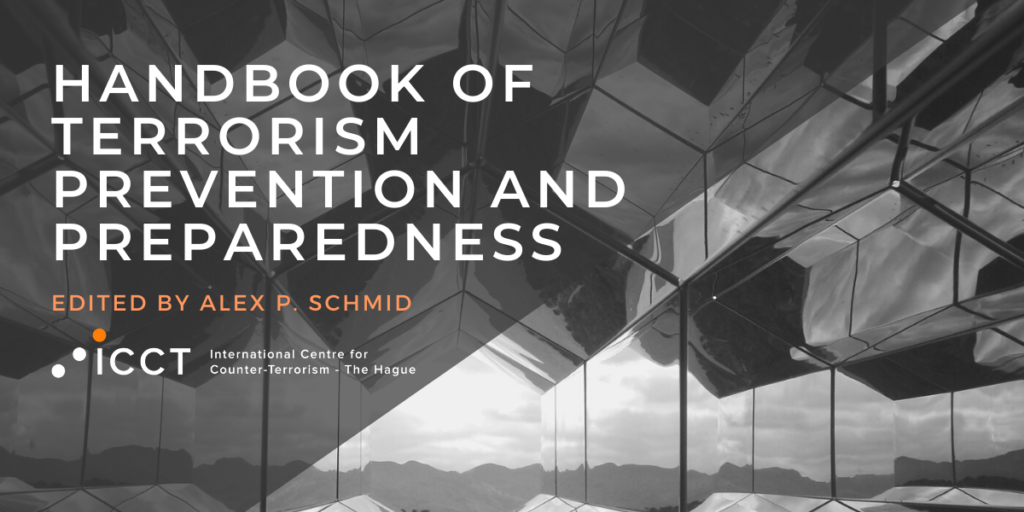In the second part of the Handbook on Terrorism Prevention and Preparedness, the authors explore outline key approaches to the prevention of radicalisation. The full table of contents can be found here.
The Handbook consists of five parts. New chapters will be released on a weekly basis. To receive a monthly update on chapter releases, subscribe here.
Part II: Prevention of Radicalization
Chapter 7: At the Crossroads: Rethinking the Role of Education in Preventing and Countering Violent Extremism
by Thomas K. Samuel
Abstract
This chapter looks at the issue of violent extremists and terrorists targeting the education sector, and subsequently recommends steps that the education sector can take to prevent and counter violent extremism (PCVE) amongst students. Educational institutions in general and students in particular have been targeted by violent extremists and terrorists. Paradoxically, they have sought to physically attack and destroy institutions of learning, while at times, they have actively sought to radicalize and subsequently recruit students to join their cause. Short case studies of attacks on educational institutions in different parts of the world, as well as instances of young people being radicalized in schools and universities, are presented and evaluated.
Chapter 8: Prevention of Radicalization to Terrorism in Prisons: A Practical Guide
by Gary Hill
Abstract
This chapter focuses more on the practical than the theoretical. Much of the chapter will focus on how to identify inmates (and staff) at risk of becoming radicalized and how to work with them. In addition to looking at potential radical inmates, the chapter also deals with violent extremist offenders, who prison professionals often include when dealing with radical inmates. Why and how individuals become radicalized in prisons is explored. Many news articles, political presentations, and common knowledge indicate that prisons are “hotbeds for the recruitment of radicals” and that this is a big problem. Whether that is true is examined. The current emphasis on developing prison programs dealing with radicals are reviewed and summarized. The issue of whether radicalization in prisons is worthy of special programs or whether normal good prison practice would be just as effective is explored. Issues of dealing with inmates who enter the prison system already radicalized and who are possibly members of radical or terrorist organizations are explored, and the types of classification tools used to identify them are discussed. The chapter also looks at differing concepts as to how and where potential radicals should be housed. A major section of the chapter deals with the training of prison staff to identify and work with potential radicals. The use of “Dynamic Security” as a tool to help in the fight against prison radicalization is explained. Examples of various treatment models used in the rehabilitation of terrorists are presented. In its final section, the chapter offers general observations and recommendations for working with radicals, convicted terrorists and violent extremist prisoners.
Chapter 9: Prevention of Radicalization to Terrorism in Refugee Camps and Asylum Centers
by Barbara H. Sude
Abstract
Only a minority of refugees and asylum seekers become terrorists, but some have committed major attacks, raising concern among host country governments and publics. This chapter identifies factors that contributed to or deterred the rise of violent militant groups and terrorists among refugees confined to camps during major historical migration crises. It then examines current efforts to mitigate the same risks among today’s refugees in camp situations. However, more than half of refugees are not in camps, but are housed either among host country populations near the countries they fled from or in third countries, where many transition through asylum reception facilities before beginning to rebuild their lives. The main factors identified in the historical cases remain relevant to more recent situations: host government policies, security and radicalizer access, living conditions, opportunities for youth, and local economic conditions and resilience. Lessons drawn from programs by the United Nations and other stakeholders to address these factors also are relevant to third countries struggling to integrate refugees. As refugees become part of the wider society in new countries, other individual risk factors for radicalization to terrorism become key to prevention efforts. These factors are essentially the same as for non-refugees. Not all have been empirically validated, but to the extent that these are useful indicators, this chapter will examine how much they apply to refugees specifically and identify promising methods drawn from mental health, criminal justice, youth, and community programs to mitigate individuals’ susceptibility to radicalization before they commit violence.
Chapter 10: Preventing Terrorism from Students of Extremist Madrasahs: An Overview of Pakistan's Effort
by Asad Ullah Khan and Ifrah Waqar
Abstract
Historically, madrasahs as religious teaching institutions have held a position of esteem and significance in the Indian subcontinent. Since Pakistan’s independence, madrasahs have played a significant role in not only providing religious education, but also offering free board and lodging to many of the country’s poorest children. Overtime, their numbers have grown, owing to a number of national and international factors. After 9/11, a debate on regulating madrasahs and their curriculum gained strength, as links connecting extremist and terrorist elements operating in the country with these institutions were found. A number of government measures to introduce reforms and regulate madrasahs in Pakistan have been announced to date, but have mostly been unsuccessful - largely due to a lack of political will. This chapter examines the evolution, landscape, and features of the current madrasahs system and efforts to streamline them, the obstacles in their implementation, along with an overview and evaluation of Pakistan’s counterterrorism strategies related to madrasahs and, to a lesser extent, mosque reforms. The social setting of madrasahs and their role in education, politics, radicalization and terrorism is also discussed in some detail.
Chapter 11: Prevention of Radicalization in Western Muslim Diasporas
by Nina Käsehage
Abstract
This chapter opens with a brief definition of key terms such as “Muslim diasporas,” “prevention of violent extremism” (PVE), “countering violent extremism” (CVE) and discusses the role of Islamophobia in radicalization and its impacts on the prevention of radicalization. The size of the Muslim population in each of the selected five Western countries and the appearance of jihadist, left- and right-wing-groups, as well as the number of attacks resulting from these milieus are briefly discussed at the beginning of the country reports. The main body of this chapter discusses academic, governmental, and civil society approaches to PVE/CVE. For each country, some PVE examples are presented which might be helpful to policymakers and practitioners. A literature review regarding PVE/CVE approaches in each country seeks to provide an overview of the academic state of the art concerning the prevention of radicalization. Finally, a number of recommendations with regard to future PVE initiatives are provided, based on the author’s field research in Salafi milieus in various European countries.
Chapter 12: Prevention of Radicalization on Social Media and the Internet
by Sara Zeiger and Joseph Gyte
Abstract
In the age of selfies, snaps, likes and shares, the internet and social media have transformed the way in which people communicate. In early 2019, global internet penetration reached 57%, or 4.4 billion users, and the overall number of mobile social media users reached 42%, or 3.2 billion people. This means that people are able to share ideas, communicate and interact more rapidly than ever before, including with audiences on the other side of the world. Terrorist groups have certainly leveraged these new mechanisms and platforms for communicating amongst themselves and to potential recruits. For example, the Islamic State of Iraq and al-Sham (ISIS) has been known for producing sleek videos circulated on YouTube and Twitter, and has mastered new and emerging technologies and social media platforms, such as Telegram; all to promote its messages and recruit new members in cyberspace. This chapter focuses on the prevention of radicalization on social media and the internet in this digital age. It first reviews the relevant methods and approaches that terrorists employ to spread their propaganda and recruit online. Subsequently, it looks at some of the more common and emerging prevention and preparedness strategies which address the online space. Besides reviewing the theoretical foundations to prevent radicalization on social media and the internet, this chapter will also draw upon specific examples, predominantly from three regions: Europe, Southeast Asia and East Africa, to illustrate what some countries are doing to tackle the problem of online radicalization.







